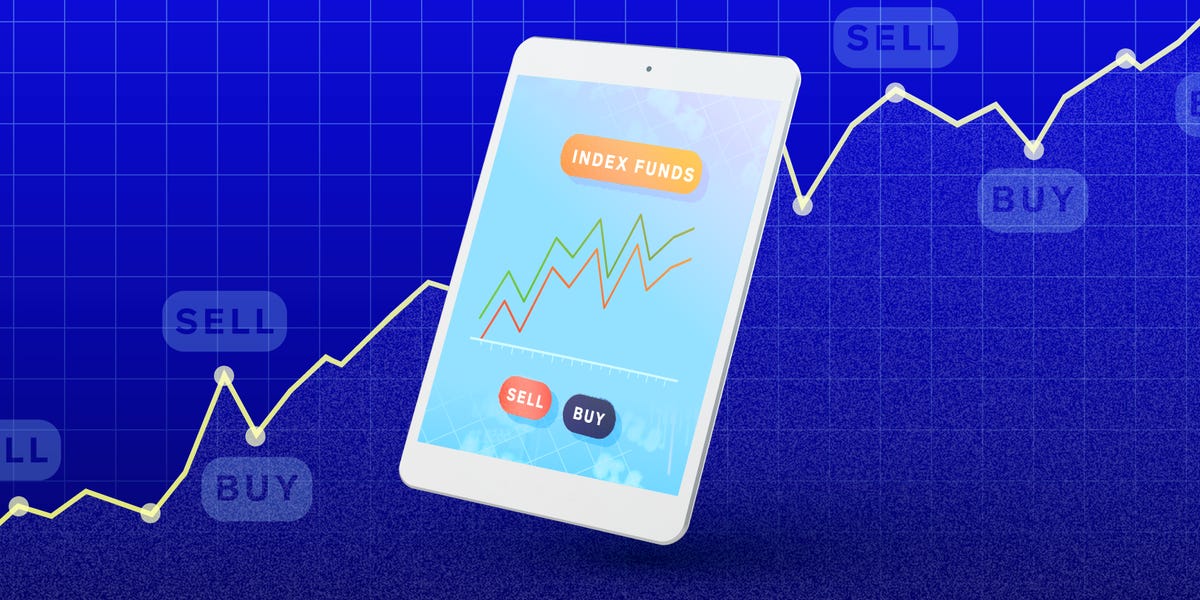Paid non-client promotion: Affiliate links for the products on this page are from partners that compensate us (see our advertiser disclosure with our list of partners for more details). However, our opinions are our own. See how we rate investing products to write unbiased product reviews.
- Index funds are a type of investment vehicle aiming to match the returns of a specific market index.
- Investing in index funds can help investors diversify a portfolio and build wealth at a low cost.
- There are many different indexes to choose from that reach various sectors and markets.
When it comes to investing, one of the most common, data-backed ways to reliably build wealth is by investing in an index fund, rather than trying to pick the stocks that you think will perform better than others.
An index fund is a type of investment vehicle, such as a mutual fund or exchange-traded fund (ETF), that tracks a market index, such as the S&P 500 or the Russell 2000. Rather than trying to beat the index, it aims to match its performance by holding a basket of securities in a similar proportion to what the index represents.
“Index funds generally benefit an investor by providing diversification and relatively low fees compared to actively managed funds. Index funds are designed to track and follow a broad sector such as large caps, emerging markets, broad indexes like the S&P 500, or it can even be as specific as tracking large technology companies, for instance,” explains Julian Schubach, SVP, wealth management at ODI Financial.
How index funds work
The way index funds work varies a bit based on factors such as the fund structure, but in general, there are two main components to index funds:
Tracking an index
Index funds track specific indexes. Indexes group securities together based on factors like size or geography. However, since securities are not directly investable, index funds provide that exposure.
In many cases, that means owning the exact same securities in an equivalent proportion to what a specific index represents. For example, an S&P 500 index fund will generally hold the same 500 companies.
If the S&P 500 drops one company out of the index and replaces it with another, the index would then sell the company that’s being dropped and buy the security of the one that’s being included.
Passive management
Index funds are passively managed, meaning that investment decisions are almost always based solely on trying to match the index.
There’s a long-running debate on active vs. passive management, but for US stocks in particular, there’s a lot of evidence that most passive funds outperform active funds over the long term.
Consistently picking winners and losers in the stock market is difficult, even for professionals, and when you factor in the higher fees and trading expenses of most actively managed funds, that helps tilt the scales toward passive.
Benefits of index funds
Index funds tend to provide a wide range of benefits to investors, such as:
- Diversification: Rather than individually buying and managing all of the stocks in the S&P 500, you can gain this diversification through one index fund.
- Low costs: Passively managed index funds are typically great for low-cost investing, especially compared to active funds, which generally charge much more.
- Transparency: Index funds are very clear about their holdings, as there’s no secret formula that they’re trying to keep from other fund managers. In contrast, with some active funds, you don’t necessarily know all of what they’ll invest in.
- Tax efficiency: Index funds generally have lower turnover than actively managed funds, meaning they do not buy and sell securities frequently, which triggers fewer taxable events. This is particularly relevant for mutual funds held in taxable accounts.
- Simplicity: You can clearly understand what you’re investing in without having to do as extensive research as you might when reviewing different active trading strategies and fund managers’ track records.
Types of index funds
Within the category of index funds, there are many different subcategories. Some refer to the asset class the fund invests in, while others refer to areas like geography or sector. Some examples include:
Equity index funds
Equity index funds, or stock index funds, track stock market indexes, such as the S&P 500 or Nasdaq-100. Many equity index funds are broad, such as covering large-cap companies.
Still, you can also find more niche equity index funds, such as those that try to match thematic indexes, like those that track socially responsible companies or innovative technology companies.
Bond index funds
Bond index funds track assets like US Treasuries, corporate bonds, or municipal bonds. There is significant variation in bond index funds, depending on factors such as:
- Maturity of the bonds (short-term vs. long-term)
- Credit rating (with lower-rated bonds typically offering higher risk and reward)
This means investors can choose bond index funds that align with their risk tolerance and investment goals.
International index funds
Some index funds, whether for stocks or other assets, follow indexes outside the US. For example, the FTSE Global All Cap ex US Index is a popular international index that tracks a wide range of stocks outside the US. Some index funds track this index, while others might track more regional ones.
Sector-specific index funds
Another option for investing in index funds is choosing sector-specific ones that track indexes in certain industries, like technology, healthcare, or energy.
This can be a good way to gain some diversification still while betting on a particular sector.
Choosing the right index fund
Although index funds are fairly straightforward, deciding which to invest in can still require some analysis.
“Each fund and fund company may have different fees and portfolio construction, though, so it is important to research the differences between each offering within a broad index,” explains Schubach. “A good way to start is to research the assets under management (AUM) of a given index fund, the fee structure, the ease of trading and access to the fund, and the background of the managers in charge of the given fund.”
When thinking about what index to invest in, consider factors such as the following:
Index fund investment goals
Before investing, it’s important to clarify your personal situation and life goals. When do you want to retire, and how far away from that milestone are you? What does your risk tolerance and budget look like?
Understanding this will help you understand the role index funds will play in your life and how to invest in them.
For example, if you’re close to retirement, you might prefer the relative stability of a bond index fund rather than an equity index fund.
It’s important to note that risk and volatility are a part of investing and can’t be completely avoided. Still, some index funds are inherently riskier than others, albeit perhaps for more potential reward.
Also, consider how every dollar you spend or invest can be used as a vote to support something based on your values. For example, to support the environment, you might focus on clean-energy index funds and other ESG investing opportunities. If you’re interested in tech or supporting women-led companies, there are index funds for that.
Investment minimums for index funds
Index funds at different companies can have similar goals but have different short- and long-term costs to consider.
One of those costs could be the upfront investment minimum needed to buy into the fund. This generally applies to mutual funds rather than ETFs. A high investment minimum could mean paying lower annual fees, though, so you’ll want to explore your options.
Expense ratio
The expense ratio is the annual percentage-based charge that encompasses all fees related to managing the fund. These costs can take a chunk of your wealth without you realizing it, so it’s important to scrutinize even slight fee differences carefully.
Tax-cost ratio
Mutual funds can lose a portion of their returns due to taxes, so the tax-cost ratio is a measure by Morningstar that tracks this percentage.
Tracking error
While index funds try to match their underlying indexes, sometimes they’re slightly off. This variance in returns is known as a tracking error. Research how closely the fund tracks its underlying index before picking one.
Fund size and liquidity
In many cases, larger funds offer more liquidity and lower trading costs, but you’ll still want to compare different funds to understand how easy it would be to liquidate if needed.
How to start investing in index funds
To start investing in index funds, you’ll want to first decide whether to do so yourself or access professional help. This determines what type of investment account you’ll need to open to purchase index fund shares.
“Investors first must decide if they want to pick the index funds themselves and manage the allocations directly. If the investor feels this is the best route for them, they can establish an investment account at any of the numerous brokerage platforms such as Fidelity, Charles Schwab, or even app-based platforms such as Robinhood,” notes Schubach. “In this scenario, the investor would research the universe of index funds available and purchase the funds they’d like to own.”
You can do this by:
- Opening an online brokerage account: You could open an account with brokerages such as Fidelity or Vanguard to manually invest in funds yourself.
- Using a robo-advisor: You could also use one of the best robo-advisors, which does much of the heavy lifting for you by investing and rebalancing automatically.
- Hiring a professional: Consult a financial manager or advisor to do more research and administrative work for you.
“For those who wish to invest in index funds, but prefer some help, they can work with a financial advisor who can help guide them to the funds which best match their risk tolerance, and they would subsequently manage those funds for the investor,” says Schubach.
In this scenario, you can work with an investment professional, like a CFP, who can help guide you through the process. This option may be more costly, however.
In deciding which route to take, consider key questions like:
- What type of fund selection and guidance do they offer?
- If using a brokerage account yourself, how convenient is it to use the platform? Do they have a mobile app, and is the user experience good?
- How much does it cost, such as transaction fees directly through a brokerage account or financial advisor management fees?
The key is having a strategy that works for you while minimizing costs. One way to keep costs down is to review the expense ratios in the prospectuses of different index funds and see if there are commission-free trading options.
The best stock trading apps can help you find commission-free trading options.
Continue to manage your investments
Once you’ve started investing in index funds, you typically want to do two things:
- Continue to invest regularly: This may mean setting up automatic monthly contributions or setting a schedule when you add more money to your portfolio. Your investments ideally will grow on their own, but continuing to invest helps you add fuel to the fire.
- Check in regularly — but not obsessively — with your investments: Consider checking in at least once a year or quarterly. Many index funds rebalance on their own, but it’s a good idea to check that your funds align with your portfolio’s goals.
FAQs about index funds
Yes, index funds are often good for beginners because of their simplicity, low cost, and diversification. The specific index fund makes a difference, though, as some are more geared toward beginners than others.
In some sense, index funds are equivalent to the market, i.e., an index fund that tracks the S&P 500. Because indexes are not directly investable, index fund fees generally create a slight lag compared to indexes. However, index funds often outperform actively managed funds over the long term.
You can buy an index fund directly through an index-fund provider like Vanguard or Fidelity. You can also invest in index funds through other brokerage accounts and certain investment apps. However, not all online brokerages and platforms offer index funds, so research the brokerage before opening an account.











Leave a Reply